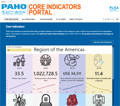
Curaçao - Profile
The Health in the Americas+ country profiles are based on the interagency indicators available as of the dates referenced. The sources are referenced in this table. In some cases, the values of the indicators may differ from the most recent data available in the country.
Environmental and social determinants of health
In 2000 the total population of Curaçao was 145 529 inhabitants; by 2024 this figure had risen to 185 482, representing a 27.5% increase. Regarding the country’s demographic profile, in 2024 people over 65 years of age accounted for 16.8% of the total population, an increase of 7.6 percentage points compared to the year 2000. In 2024, there were 110.1 women per 100 men and 112.4 older people (65 years or older) per 100 children under 15 years of age, as can be seen in the country’s population pyramids, distributed by age group and sex (Figure 1). Considering the population between 15 and 64 years of age to be potentially active (i.e., potential participants in the labor force), this group represented 68.3% of the total population of the country in 2024 ( 126 666 people). When we add these figures to the potentially passive population ( 27 689 under 15 years of age and 31 127 over 65 years of age), the result is a dependency ratio of 46.4 potentially passive people per 100 potentially active people. This ratio was 55.5 in 2000.
Life expectancy at birth in 2024 was 77 years, lower than the average for the Region of the Americas and 3.7 years higher that in 2000 (73.3).
Figure 1. Population pyramids, years 2000 and 2024
Digital coverage
In 2017, 68.1% of the population had an internet connection, representing a considerable increase from 2016, when 61.9% of the population had an internet connection.
Health situation
Maternal and child health
Between 2000 and 2021, infant mortality in Curaçao increased from 8.2 to 13.8 deaths per 1000 live births, a decrease of 68.3% (Figure 4).
Regarding the immunization strategy, measles vaccination coverage was 92% in 2019, a decrease of one percentage point from 2000.
In relation to fertility, it is estimated that in 2024 women had an average of 1.1 children throughout their reproductive lives. In the specific case of adolescent fertility, there was a 73.3% decrease, from 46.7 live births per 1000 women aged 15 to 19 years in 2000 to 12.5 in 2024. In 2017, 99% of births were attended by skilled birth personnel.
Figure 2. Infant mortality per 1000 live births, 1998–2021
Communicable diseases
In 2022, there were 3 new cases of tuberculosis per 100 000 population in Curaçao. In 2015, the estimated human immunodeficiency virus (HIV) infection incidence rate (new diagnoses) was 50.7 per 100 000 population.
Noncommunicable diseases and risk factors
The prevalence of overweight and obesity in the same age group was 64.9% for 2017.
Regarding arterial hypertension, a prevalence of 21.3% was reported in 2017, which represents an increase of 1.4 points compared to 2013 (19.9%). On the other hand, the prevalence of Diabetes Mellitus decreased to 8.4% in 2017 after being 9.3% in 2013.
The sources of the interagency indicators used in this profile can be found in this table.
 For the latest data on health indicators for the Region of the Americas, be sure to visit the PAHO Core Indicators portal.
For the latest data on health indicators for the Region of the Americas, be sure to visit the PAHO Core Indicators portal.
County COVID-19 Perspective
Status of the COVID-19 Pandemic
In Curaçao in 2020, there were a total of 4 231 cases of COVID-19, representing 22,238 per million population. In 2021, there were 16,480 identified cases, equivalent to 86,617 per million population. In 2022, there were 24,635 identified cases, equivalent to 129,478 per million population. In 2020, there were 14 deaths directly caused by COVID-19 in people diagnosed with the disease, or 74 per million population; in 2021, 175 deaths were reported, or 920 per million. In 2022, 98 deaths directly caused by COVID-19 in people diagnosed with the disease, or 515 per million population. In 2020, Curaçao ranked 36th in the Region of the Americas in terms of the number of deaths from COVID-19, and 12th in 2022, with a cumulative 1,508 deaths per million population over the considered years (Figure 2).
On December 31, 2021, 65.7% of the country's population had at least one dose of COVID-19 vaccine applied. As of April 20, 2022 (latest available data), 60% of the population had the complete schedule. The vaccination campaign started on February 20, 2021 and 3 types of COVID-19 vaccines have been used in the country so far.
Figure 3. Cumulative COVID-19 deaths in the Region of the Americas, to July 29th, 2023
Perspective
Life expectancy at birth has continued to increase steadily, as has the percentage of the population over the age of 65. These indicators place Curacao among the oldest countries in the region. This change in the demographic profile will constitute a growing challenge for the health system, stimulating its reconfiguration.
Infant mortality remains stable at relatively low values; however, mortality in children under 5 years of age has increased in the last period.
During the pandemic, consultations related to mood disorders such as depression and anxiety as well as substance abuse increased. In this regard, PAHO provided technical assistance to strengthen this area.
COUNTRY/TERRITORY PROFILES
Anguilla
Antigua and Barbuda
Argentina
Aruba
Bahamas
Barbados
Belize
Bermuda
Bolivia
Bonaire, Sint Eustatius, and Saba
Brazil (English) (Português)
Canada
Cayman Islands
Chile
Colombia
Costa Rica
Cuba
Curaçao
Dominica
Dominican Republic
Ecuador
El Salvador
French Guiana, Guadeloupe and Martinique
Grenada
Guatemala
Guyana
Haiti (English) (Français)
Honduras
Jamaica
Mexico
Montserrat
Nicaragua
Panama
Paraguay
Peru
Puerto Rico
Saint Kitts and Nevis
Saint Lucia
Saint Vincent and the Grenadines
Sint Maarten
Suriname
Trinidad and Tobago
Turks and Caicos Islands
United States of America
Uruguay
Venezuela
Virgin Islands (British)
Virgin Islands (U.S.)


